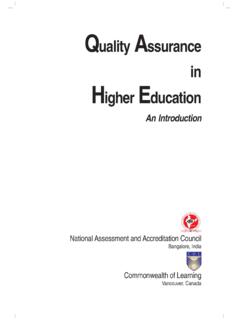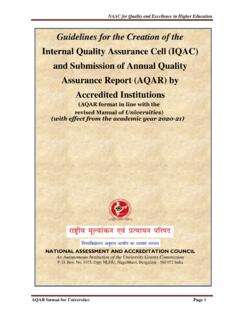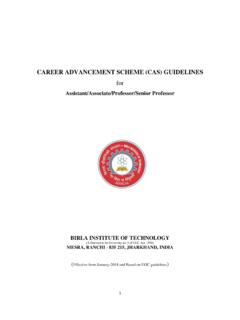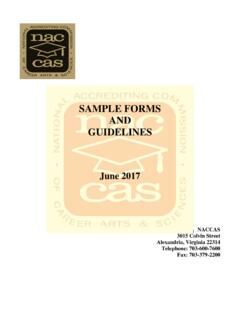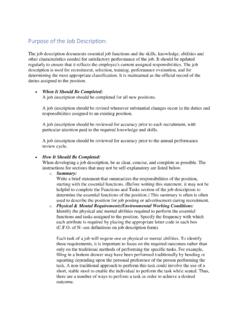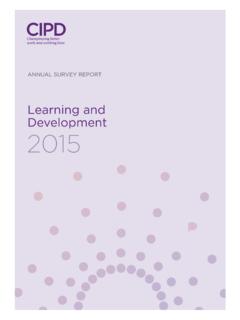Transcription of Internal Quality Assurance Cell (IQAC) and Submission of ...
1 guidelines of IQAC and Submission of AQAR for Autonomous Colleges Page 1 Version 5 dated 12-01-2018 (23/5/2018) guidelines for the Creation of the Internal Quality Assurance Cell (IQAC) and Submission of Annual Quality Assurance Report (AQAR) by Accredited Institutions (For Autonomous Colleges) (Revised as per Revised Accreditation Framework in November, 2017) NATIONAL ASSESSMENT AND ACCREDITATION COUNCIL An Autonomous Institution of the University Grants Commission P. O. Box. No. 1075, Opp: NLSIU, Nagarbhavi, Bengaluru - 560 072 India guidelines of IQAC and Submission of AQAR for Autonomous Colleges Page 2 guidelines of IQAC and Submission of AQAR for Autonomous Colleges Page 3 NAAC VISION To make Quality the defining element of higher education in India through a combination of self and external Quality evaluation , promotion and sustenance initiatives.
2 MISSION To arrange for periodic assessment and accreditation of institutions of higher education or units thereof, or specific academic programmes or projects; To stimulate the academic environment for promotion of Quality of teaching-learning and research in higher education institutions; To encourage self- evaluation , accountability, autonomy and innovations in higher education; To undertake Quality -related research studies, consultancy and training programmes, and To collaborate with other stakeholders of higher education for Quality evaluation , promotion and sustenance.
3 Value Framework To promote the following core values among the HEIs of the country: Contributing to National Development Fostering Global Competencies among Students Inculcating a Value System among Students Promoting the Use of Technology Quest for Excellence guidelines of IQAC and Submission of AQAR for Autonomous Colleges Page 4 guidelines for the Creation of the Internal Quality Assurance Cell (IQAC) and Submission of Annual Quality Assurance Report (AQAR) by Accredited Institutions (For Autonomous Colleges) (Revised as per Revised Accreditation Framework in November, 2017) NATIONAL ASSESSMENT AND ACCREDITATION COUNCIL An Autonomous Institution of the University Grants Commission P.
4 O. Box. No. 1075, Opp: NLSIU, Nagarbhavi, Bengaluru - 560 072 India guidelines of IQAC and Submission of AQAR for Autonomous Colleges Page 5 Published by: The Director National Assessment and Accreditation Council (NAAC) P. O. Box. No. 1075, Nagarbhavi, Bengaluru - 560 072, India Prepared by: Dr. Ganesh A. Hegde, Deputy Adviser, NAAC Dr. Vinita Sahoo, Assistant Adviser, NAAC Copyright NAAC December 2017 All rights reserved. No part of this publication may be reproduced or utilised in any form or by any means, electronic or mechanical, including photocopying, recording, or any information storage and retrieval system, without the prior written permission of the publisher.
5 Printed at: guidelines of IQAC and Submission of AQAR for Autonomous Colleges Page 6 Contents Page Nos. 1. Introduction .. 4 2. Objective .. 4 3. Strategies .. 4 4. Functions .. 5 5. Benefits .. 5 6. Composition of the IQAC .. 6 7. The role of coordinator .. 7 8. Operational Features of the IQAC .. 7 9. Revised Accreditation Framework .. 8 10. Mandatory Submission of AQAR by IQAC .. 8 11. The Annual Quality Assurance Report (AQAR) .. 8 Part A 11. Details of the Institution .. 9 12. IQAC Composition and Activities.
6 12 Part B 13. Criterion I: Curricular Aspects .. 14 14. Criterion II: Teaching, Learning and evaluation .. 15 15. Criterion III: Research, Innovations and Extension .. 17 16. Criterion IV: Infrastructure and Learning Resources .. 20 17. Criterion V: Student Support and Progression .. 22 18. Criterion VI: Governance, Leadership and Management .. 24 19. Criterion VII: Institutional Values and Best Practices .. 27 20. Abbreviations .. 29 guidelines of IQAC and Submission of AQAR for Autonomous Colleges Page 7 guidelines for the Creation of the Internal Quality Assurance Cell (IQAC) and Submission of Annual Quality Assurance Report (AQAR) in Accredited Institutions Introduction In pursuance of its Action Plan for performance evaluation , assessment and accreditation and Quality up-gradation of institutions of higher education, the National Assessment and Accreditation Council (NAAC)
7 , Bangalore proposes that every accredited institution should establish an Internal Quality Assurance Cell (IQAC) as a Quality sustenance measure. Since Quality enhancement is a continuous process, the IQAC will become a part of the institution s system and work towards realisation of the goals of Quality enhancement and sustenance. The prime task of the IQAC is to develop a system for conscious, consistent and catalytic improvement in the overall performance of institutions. For this, during the post-accreditation period, institutions need to channelize its efforts and measures towards promoting the holistic academic excellence including the peer committee recommendations.
8 The guidelines provided in the following pages will guide and facilitate the institution in the creation and operation of the Internal Quality Assurance Cell (IQAC). The work of the IQAC is the first step towards internalization and institutionalization of Quality enhancement initiatives. Its success depends upon the sense of belongingness and participation in all the constituents of the institution. It will not be yet another hierarchical structure or a record-keeping exercise in the institution. It will be a facilitative and participative voluntary system/unit/organ of the institution.
9 It has the potential to become a vehicle for ushering in Quality enhancement by working out planned interventionist strategies by IQAC to remove deficiencies and enhance Quality like the Quality Circles in industries. IQAC Vision To ensure Quality culture as the prime concern for the Higher Education Institutions through institutionalizing and internalizing all the initiatives taken with Internal and external support. Objective The primary aim of IQAC is To develop a system for conscious, consistent and catalytic action to improve the academic and administrative performance of the institution.
10 To promote measures for institutional functioning towards Quality enhancement through internalization of Quality culture and institutionalization of best practices. Strategies guidelines of IQAC and Submission of AQAR for Autonomous Colleges Page 8 IQAC shall evolve mechanisms and procedures for a) Ensuring timely, efficient and progressive performance of academic, administrative and financial tasks; b) Relevant and Quality academic/ research programmes; c) Equitable access to and affordability of academic programmes for various sections of society; d) Optimization and integration of modern methods of teaching and learning; e) The credibility of assessment and evaluation process.


